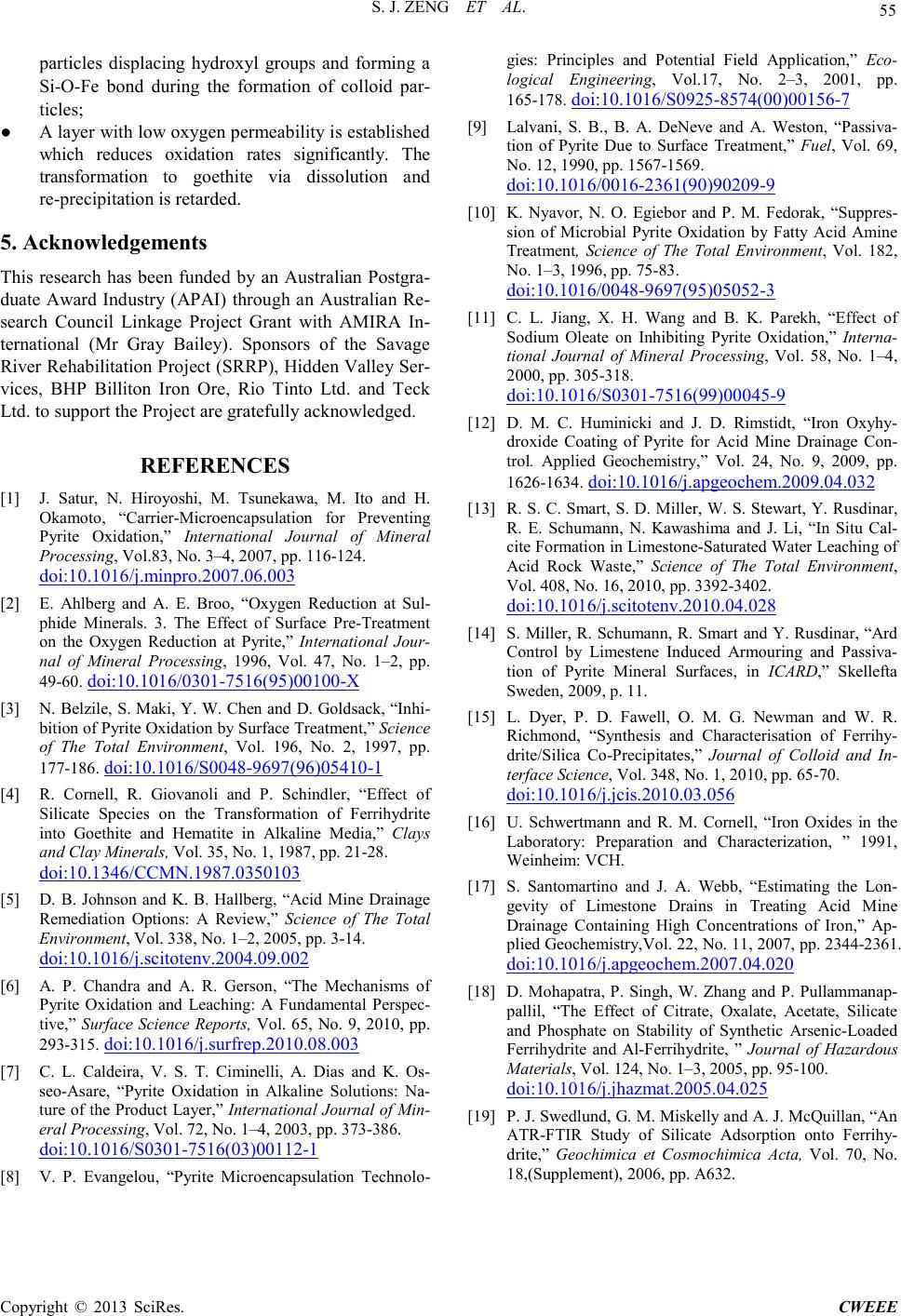
S. J. ZENG ET AL.
Copyright © 2013 SciRes. CWEEE
particles displacing hydroxyl groups and forming a
Si-O-Fe bond during the formation of colloid par-
ticles;
● A layer with low oxygen permeability is established
which reduces oxidation rates significantly. The
transformation to goethite via dissolution and
re-precipitation is re ta r ded.
5. Acknowledgements
This research has been funded by an Australian Postgra-
duate Award Industr y (APAI) through an Australian Re-
search Council Linkage Project Grant with AMIRA In-
ternational (Mr Gray Bailey). Sponsors of the Savage
River Rehab ilitation Pro ject (SRRP), Hidden Valley Ser-
vices, BHP Billiton Iron Ore, Rio Tinto Ltd. and Teck
Ltd. to support the Project are gratefully acknowledged.
REFERENCES
[1] J. Satur, N. Hiroyoshi, M. Tsunekawa, M. Ito and H.
Okamoto, “Carrier-Microencapsulation for Preventing
Pyrite Oxidation,” International Journal of Mineral
Processing , Vol . 83, No. 3–4, 2007, pp. 116-124.
doi:10.1016/j.minpro.2007.06.003
[2] E. Ahlberg and A. E. Broo, “Oxygen Reduction at Sul-
phide Minerals. 3. The Effect of Surface Pre-Treatment
on the Oxygen Reduction at Pyrite,” International Jour-
nal of Mineral Processing, 1996, Vol. 47, No. 1–2, pp.
49-60. doi:10.1016/0301-7516(95)00100-X
[3] N. Belzi le, S. Maki, Y. W. Ch en and D. Goldsack, “Inhi-
biti on of P yrite Oxid atio n by Sur face Treat ment,” Science
of The Total Environment, Vol . 196, No. 2, 1997, pp.
177-186. doi:10.1016/S0048-9697(96)05410-1
[4] R. Cornell, R. Giovanoli and P. Schindler, “Effect of
Silicate Species on the Transformation of Ferrihydrite
into Goethite and Hematite in Alkaline Media,” Clays
and Clay Minerals, Vol. 35, No. 1, 1987, pp. 21-28.
doi:10.1346/CCMN.1987.0350103
[5] D. B. Johnson and K. B. Hallberg, “Acid Mine Drainage
Remediation Options: A Review,” Science of The Total
Environment, Vol. 338, No. 1–2, 2005, pp. 3-14.
doi:10.1016/j.scitotenv.2004.09.002
[6] A. P. Chandra and A. R. Gerson, “The Mechanisms of
Pyrite Oxidation and Leaching: A Fundamental Perspec-
tive,” Surface Science Reports, Vol. 65, No. 9, 2010, pp.
293-315. doi:10.1016/j.surfrep.2010.08.003
[7] C. L. C aldeira, V. S. T. Ciminelli, A. Dias and K. Os-
seo-Asare, “Pyrite Oxidation in Alkaline Solutions: Na-
ture of the Product Layer,” International Journal of Min-
eral Processing, Vol . 72, No. 1–4, 2003, pp. 373-386.
doi:10.1016/S0301-7516(03)00112-1
[8] V. P. Evangelou, “Pyrite Microencapsulation Technolo-
gies: Principles and Potential Field Application,” Eco-
logical Engineering, Vol.17, No. 2–3, 2001, pp.
165-178. doi:10.1016/S0925-8574(00)00156-7
[9] Lalvani, S. B., B. A. DeNeve and A. Weston, “Passiva-
tion of Pyrite Due to Surface Treatment,” Fuel, Vol. 69,
No. 12, 1990, pp. 1567-1569.
doi:10.1016/0016-2361(90)90209-9
[10] K. Nyavor, N. O. Egiebor and P. M. Fedorak, “Suppres-
sion of Microbial Pyrite Oxidation by Fatty Acid Amine
Treatment, Science of The Total Environment, Vo l. 182,
No. 1–3, 1996, pp. 75-83.
doi:10.1016/0048-9697(95)05052-3
[11] C. L. Jiang, X. H. Wang and B. K. Parekh, “Effect of
Sodium Oleate on Inhibiting Pyrite Oxidation,” Interna-
tional Journal of Mineral Processing, Vol. 58, No. 1–4,
2000, pp. 305-318.
doi:10.1016/S0301-7516(99)00045-9
[12] D. M. C. Huminicki and J. D. Rimstidt, “Iron Oxyhy-
droxide Coating of Pyrite for Acid Mine Drainage Con-
trol. Applied Geochemistry,” Vol. 24, No. 9, 2009, pp.
1626-1634. doi:10.1016/j.apgeochem.2009.04.032
[13] R. S. C. Smart, S. D. Miller, W. S. Stewart, Y. Rusdinar,
R. E. Schumann, N. Kawashima and J. Li, “In Situ Cal-
cite Formation in Limestone-Saturated Water Leach in g of
Acid Rock Waste,” Science of The Total Environment,
Vol. 408, No. 16, 2010, pp. 3392-3402.
doi:10.1016/j.scitotenv.2010.04.028
[14] S. Miller, R. Schumann, R. Smart and Y. Rusdinar, “Ard
Control by Limestene Induced Armouring and Passiva-
tion of Pyrite Mineral Surfaces, in ICARD,” Skellefta
Sweden, 2009, p. 11.
[15] L. Dyer, P. D. Fawell, O. M. G. Newman and W. R.
Richmond, “Synthesis and Characterisation of Ferrihy-
drite/Silica Co-Preci pitates,” Journal of Colloid and In-
terface Science, Vol. 348, No. 1, 2010, pp. 65-70.
doi:10.1016/j.jcis.2010.03.056
[16] U. S chwertmann and R. M. Cornell, “Iron Oxides in the
Laboratory: Preparation and Characterization, ” 1991,
Weinheim: VCH.
[17] S. Santomartino and J. A. Webb, “Estimating the Lon-
gevity of Limestone Drains in Treating Acid Mine
Drainage Containing High Concentrations of Iron,” Ap-
plied Geochemistry,Vol. 22, No. 11, 2007, p p. 2344-2361.
doi:10.1016/j.apgeochem.2007.04.020
[18] D. Mohapatra, P. Singh, W. Zhang and P . Pullammanap-
pallil, “The Effect of Citrate, Oxalate, Acetate, Silicate
and Phosphate on Stability of Synthetic Arsenic-Loaded
Ferrihydrite and Al-Ferrihydrite, ” Journal of Hazardous
Materials, Vol. 124, No. 1–3, 2005, pp. 95-100.
doi:10.1016/j.jhazmat.2005.04.025
[19] P. J. Swedlund, G. M. Miskelly and A. J. McQuillan, “An
ATR-FTI R Study of Silicate Adsorption onto Ferrihy-
drite,” Geochimica et Cosmochimica Acta, Vol. 70, No.
18,(Supplement), 2006, pp. A632.